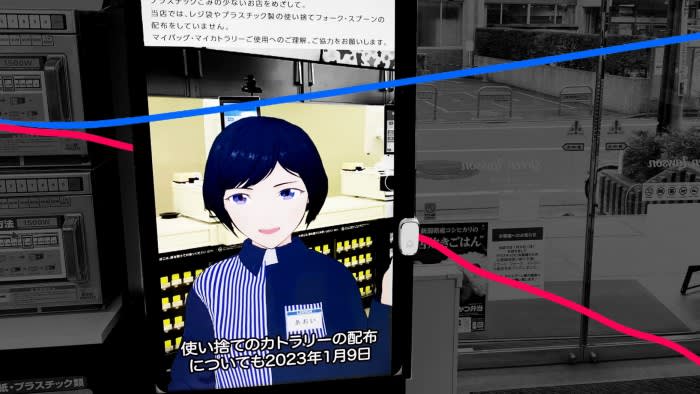With 500 days remaining until the commencement of the Osaka World Expo in spring 2025, Hiroyuki Ishige, the secretary-general, has affirmed the public that the extravagant global exhibition will be prepared punctually.
Although Ishige’s assurance appears genuine, the necessity for him to address this issue stems from a crisis well beyond his influence. The Expo, situated on a desolate, undeveloped site, has become the most prominent casualty of a nationwide scarcity of construction workers.
The deficiency of workers in the world’s rapidly aging economy is significantly impacting the operations and future outlook of the government, businesses, and individuals.
This labor shortage is affecting even Japan’s most renowned service-oriented industries. For instance, Central Japan Railway discontinued the cherished food trolley service on the Tokyo-Osaka bullet train in October. Moreover, vending machines across the nation are increasingly left empty for extended periods.
Shoto Furuya, the chief researcher at the Recruit Works Institute, highlighted, “Japan’s labor shortage persists regardless of the economic conditions. We are facing a shortfall in vital services crucial for sustaining people’s lifestyles and social infrastructure.”
Projections from RWI suggest that by 2040, Japan could face a labor deficit of 11 million individuals, with the population aged above 65, already constituting nearly 30% of the total populace, expected to peak in 2042.
Over the past decade, Japan has leaned on female and elderly employees due to stringent regulations on hiring foreign workers. However, Naruhisa Nakagawa, the founder of hedge fund Caygan Capital, emphasized that this approach will no longer suffice, and the country’s workforce will gradually diminish.
The response of Asia’s largest advanced economy to this labor crisis will be closely monitored, particularly by neighboring China, which is also experiencing a population decline.
To combat the demographic challenges, Japan is introducing avatars, robots, and artificial intelligence into pivotal sectors of the workforce:
In Japan’s construction industry, efforts to attract more women and young workers through various means, such as increasing wages and providing modern work attire, have fallen short. Despite these initiatives, the number of construction workers has decreased by 30% to 4.8 million from its peak in 1997, according to the Ministry of Land, Infrastructure, Transport and Tourism.
The data from the ministry also reveals that only 12% of construction workers are under 29 years old, while approximately 36% are over 55. The sector’s staffing challenges are so severe that it has been granted a five-year period to prepare for new labor regulations effective from April, limiting overtime for construction workers and truck drivers.
As the impact of these shortages intensifies, the estimated cost of the Expo has surged to over $1.6 billion, compelling contractors to offer higher wages to attract workers. Some countries, apprehensive of escalating expenses and delays, are downsizing their participation. Diplomats caution that Japan’s prestigious national exhibition could directly suffer from the labor deficiencies.
For Daniel Blank, the CEO of start-up Toggle, this crisis presents a business opportunity.
Blank, who traveled from New York to Japan last year, advocates for the use of industrial robots to automate the labor-intensive process of assembling reinforcement bars for construction companies. Toggle recently secured a combined $1.5 million investment from Tokyu Construction and Takemura, another Japanese construction firm.
“Japanese companies are exploring new technologies worldwide,” Blank stated. “This drive is primarily fueled by the labor shortage. With labor becoming scarcer and more expensive, innovative approaches are necessary to execute construction projects.”
Traditionally, Lotte, a prominent confectionery manufacturer, delivered its popular chocolate-filled, bear-shaped biscuits, Koala’s March, via trucks. However, in anticipation of a severe shortage of drivers due to changes in overtime regulations, the company will now use trains to distribute one of Japan’s beloved children’s snacks.
Various companies in Japan, including Toyota and Rakuten, are also adapting to the labor scarcity by developing robots, self-driving vehicles, and engaging in mergers with smaller competitors.
The shortage of truck drivers in Japan has led to widening intervals between vending machine refills, particularly in rural areas and even major cities. To address this challenge, JR East Cross Station, a food and beverage supplier, initiated the use of trains in November to replenish some vending machines with canned drinks.
At Toyota’s Motomachi plant in Aichi prefecture, the company has implemented a fleet of “vehicle logistics robots” to transport cars to the loading area. Toyota aims to eventually replace 22 human workers at the facility with 10 robots.
“The shortage of truck drivers has been a longstanding issue, not limited to 2024,” mentioned a Toyota manager. “While these initiatives are crucial, they alone cannot compensate for the required number of drivers.”
In the agricultural landscapes of Miyazaki prefecture, a robot duck named Raicho 1, developed by Kyoto-based robot maker Tmsuk, was deployed last summer to eliminate weeds in rice paddies. This solar-powered robot, along with other drones and robots, was designed to sow, nurture, and harvest rice crops autonomously. As the human population in the area diminishes, wild animals like boars and deer roam more freely, prompting innovative solutions for crop protection.
The experiment conducted during the rice harvest in October showcased promising results for both the company and Japan. The total human labor hours involved in the process decreased from 529 to 29, marking a 95% reduction in manpower with only a 20% decrease in rice yield.
As Japan’s population dwindles and ages, the agricultural sector faces severe labor shortages. Government statistics indicate that in terms of calorie production, Japan was self-sufficient for only 38% of its requirements in 2022, falling short of the government’s goal of 45% by 2030.
With the rate of abandoned farmlands surpassing 10%, concerns are mounting that Japan’s renowned agricultural products, including regional sakes and specialty foods, may be at risk of disappearing.
Given that 43% of Japanese farmers are over 75 years old and the average age of all farmers is nearly 68, Yoichi Takamoto, the CEO and founder of Tmsuk, emphasized that Japan must embrace a robotic workforce in agriculture.
In a small convenience store in central Tokyo offering a diverse range of products, an animated avatar greets customers at the entrance through a 4ft screen.
This newly installed avatar, controlled remotely by a Lawson employee, is part of a trial collaboration with Avita, the technology provider, to enhance customer service and address labor shortages.
Kazuki Tsukiuda, a senior executive at Lawson, explained, “We conceived this idea during the Covid-19 pandemic to safeguard employees and now it serves as a means for individuals who face challenges in physically attending stores to participate in the workforce.”
Looking ahead, the objective is for each operator, whether a working parent, a senior citizen rejoining the workforce, or a person with disabilities preferring remote work, to manage multiple avatars. This approach enables the retail chain to staff night shifts and rural outlets efficiently.
The shortage of labor has compelled Japanese retailers and convenience stores, known as “combini,” to reduce operating hours and services. The Japan Franchise Association reported a shortage of 172,000 convenience store workers in 2020, with a projected deficit of 101,000 employees by 2025. Consequently, 87% of “combini” stores now operate round the clock, compared to 92% in August 2019.
While recruiting foreign students, who are permitted to work despite stringent immigration regulations, is an alternative, extensive training is often necessary to meet customer service expectations. Tsukiuda noted, “Only a few comprehend the Japanese etiquette of courteous and authentic customer service and can deliver it proficiently in Japanese.”
Although only a few Lawsons currently utilize avatars, Shogo Nishiguchi, the COO at Avita, envisions deploying 100,000 avatar operators nationwide by 2030. Tsukiuda highlighted, “Avatars can sustain operations in rural areas. Even with doubled wages, the scarcity of available workers remains a pressing issue.”






